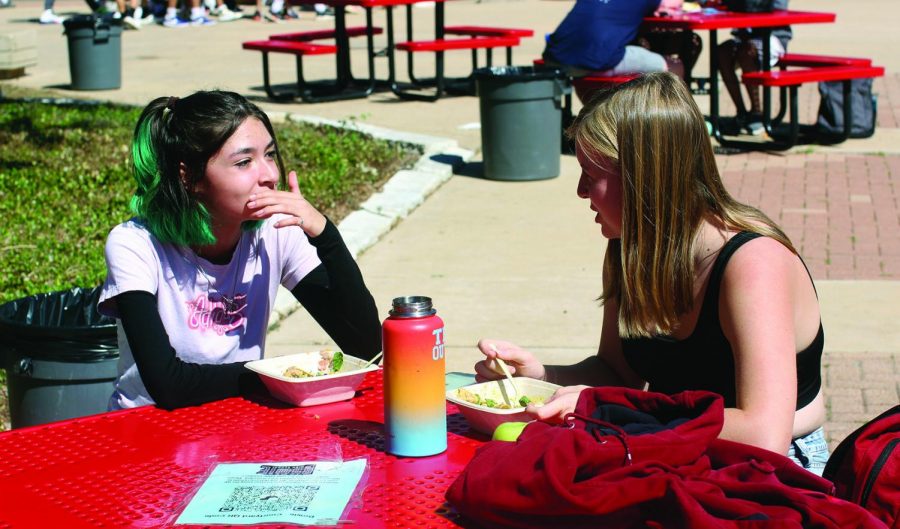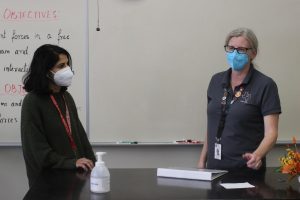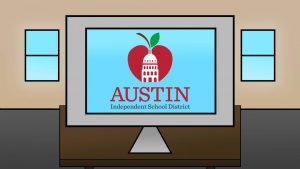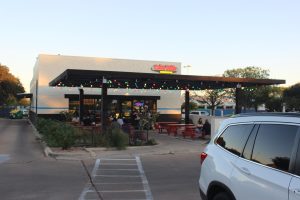Students adjust to new COVID response and protocols
ENJOYING LUNCH: Seniors Kinsey Quintanilla and Reese Wilson distancing maskless during their lunch period. The two seniors spend their time in the courtyard to social distance from large groups.
October 22, 2021
COVID-19 was declared a global pandemic in March of 2020. Since then, there have been many regulations implemented to mitigate the spread of the virus. Common recommendations for protection against COVID-19 is to get vaccinated, wear a mask, get tested, washing hands, and social distancing
In addition to these suggestions, the district has instituted other protocols to protect student like mandatory mask usage, rapid testing, and contract tracing. Along with Bowie’s new protocols, a committee led by assistant principal Jerry Smith has been established to handle Bowie’s COVID-19 response. This team is in charge of mitigation of the virus, as well as ensuring staff and students’ safety.
“It’s definitely a new challenge,” Smith said. “No one likes wearing masks all of the time, and it does present its own challenges with being able to communicate as well as we usually do. It’s a bit of a frustration but the majority of our staff and students are doing very well.”
In March of this year, Texas’ Governor Greg Abbott issued Executive Order GA No. 36, prohibiting schools from enforcing their own mask mandates. Despite this the Houston, Dallas, and Austin school districts have all instituted their own rules enforcing the use of face-coverings. AISD Superintendent Stephanie S. Elizalde announced in August, all students, staff, and visitors must wear face coverings on AISD property.
“I am responsible for the safety, health and welfare of each and every one of our students and our staff,” Elizalde said. “I must be on the side of ensuring that we’ve been overly cautious, not that we have fallen short.”
Last year students had the option to return to school for hybrid learning, where they got the option to take some classes in- person and some classes online. Students participating in this hybrid model went to school two to three days a week and spent the rest of the time doing remote learning. This plan offered the use of social distancing, as there were only about 200-300 students attending school in person each day. Now that all students have returned to campus, distancing has become more of an issue.
“There was a lot more freedom last year,” junior Danielle Cross said. “Now the teachers are less relaxed, and they’re stricter about masks now because there’s so many kids. It’s a big adjustment, going from there being less than 200 kids in the school, and now there’s almost 3000 kids.”
Students, for the most part, have been following these guidelines pretty closely. According to Smith, masks have proven an important and useful tool to the regulation of COVID-19. All of last school year AISD required masks for hybrid learners resulting in a lower positivity rate inside its schools than in the community at large.
“You always had to wear a mask, but there were definitely a lot of people that didn’t want to,” Cross said. “And because there was so few kids in the classroom, you were always well more than six feet apart from each other.”
Compulsory masks aren’t the only method Bowie is using to protect its students. Since students have returned to in-person learning, the new practice of contact tracing has emerged. Contact tracing is the process of tracking who staff and students come in contact with, alerting the school when any person has come in close proximity to any infected individual.
“I think contact tracing is a good idea in theory, but I’m not sure how effective it is in practice, because a lot of students don’t care all that much,” sophomore Charlotte Hill said. “Personally, I support contact tracing.”
When Smith and his team are notified of a positive case, they check the QR codes to find out where they eat lunch and who they have eaten lunch with. They also interview any positive students to see if they’re participating in any sports, extracurricular activities, or clubs.
“We have to get all of those questions answered, so we can let everyone know that they may have been exposed to COVID-19, and keep them safe,” Smith said.
Students are also encouraged to stay home whenever they feel sick or think they might have come into contact with the virus. There are expected spikes in absences, so teaching methods and attendance records have been adjusted. Students who in quarantine will have excused absences, and attendance incentives were canceled at the beginning of the year.
“We encourage our teachers to use BLEND as much as possible to reach out to students that are in quarantine,” Smith said. “And they don’t have to worry about accumulating absences that will impact them negatively.”
Earlier this year, the Delta variant of COVID-19 made its way to the United States and has by now become the predominant strain of the virus. The Delta variant is much more contagious, especially to children 12 and under, yet there is no vaccine approved for children aged 5-12 in the U.S.
“[COVID] is like the flu in a sense, because there’s multiple strands of it, and you got to get your flu shot every year,” Cross said. “And since it’s so new, there’s gonna be a lot more strands than just Delta and [COVID-19].”
Although it isn’t required, students are strongly encouraged to get COVID-19 vaccinations. Students who are fully vaccinated aren’t required to quarantine if they come into close contact with the virus, while unvaccinated personnel will need to stay home regardless of whether or not masks were worn. This COVID mitigation protocol is in place to prevent the contamination of anyone who hasn’t been vaccinated, especially with the Delta variant’s impact on adolescents.
“I think quarantining if you’re unvaccinated and come into close contact with COVID is a good idea, even if masks are worn, because you are at a significantly higher risk of the virus if unvaccinated,” Hill said. “Quarantining is about preventing exposure to other students, so morally I think it’s the right thing to do.”
Although all of the district’s suggestions are being followed, there have still been some students who have caught the virus. Some students feel that there’s more the school could do to mitigate the spread. Some believe there’s plenty of room for improvement, and have made suggestions for better maintenance of everyone’s health.
“I think that they should do it back to where it was online and in person again, because I know not everyone feels 100% comfortable being here,” Cross said. “And so for those students that want to stay home, they should be able to have that choice.”
Bowie has made numerous amounts of protocols to slow the spread of the COVID-19 virus. According to AISD Board President Geronimo Rodriguez, these protocols are especially important for the protection of the districts’ students who can’t get vaccinated at this time. Smith and his team believe that these regulations are crucial to the containment of COVID-19, and following them is the best way to remain safe in school.
“Even though it’s frustrating to wear a mask all the time, and do these different things, the Bowie staff and students are doing an amazing job, wearing their masks and following the protocols,” Smith said. “They’re just amazing to work with and they’re doing an excellent job of keeping everybody safe.”












